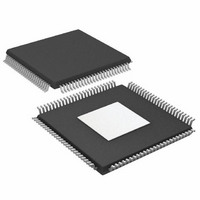AD9779ABSVZ Analog Devices Inc, AD9779ABSVZ Datasheet - Page 22

AD9779ABSVZ
Manufacturer Part Number
AD9779ABSVZ
Description
IC DAC 16BIT 1.0GSPS 100TQFP
Manufacturer
Analog Devices Inc
Specifications of AD9779ABSVZ
Data Interface
Serial
Design Resources
Interfacing ADL5370 to AD9779A Dual-Channel, 1 GSPS High Speed DAC (CN0016) Interfacing ADL5371 to AD9779A Dual-Channel, 1 GSPS High Speed DAC (CN0017) Interfacing ADL5372 to AD9779A Dual-Channel, 1 GSPS High Speed DAC (CN0018) Interfacing ADL5373 to AD9779A Dual-Channel, 1 GSPS High Speed DAC (CN0019) Interfacing ADL5374 to AD9779A Dual-Channel, 1 GSPS High Speed DAC (CN0020) Interfacing ADL5375 to AD9779A Dual-Channel, 1 GSPS High Speed DAC (CN0021)
Number Of Bits
16
Number Of Converters
2
Voltage Supply Source
Analog and Digital
Power Dissipation (max)
300mW
Operating Temperature
-40°C ~ 85°C
Mounting Type
Surface Mount
Package / Case
100-TQFP Exposed Pad, 100-eTQFP, 100-HTQFP, 100-VQFP
Resolution (bits)
16bit
Sampling Rate
1GSPS
Input Channel Type
Parallel
Digital Ic Case Style
QFP
No. Of Pins
100
Operating Temperature Range
-40°C To +85°C
Number Of Channels
2
Resolution
16b
Interface Type
Parallel
Single Supply Voltage (typ)
3.3V
Dual Supply Voltage (typ)
Not RequiredV
Architecture
Interpolation Filter
Power Supply Requirement
Analog and Digital
Output Type
Current
Single Supply Voltage (min)
3.13V
Single Supply Voltage (max)
3.47V
Dual Supply Voltage (min)
Not RequiredV
Dual Supply Voltage (max)
Not RequiredV
Operating Temp Range
-40C to 85C
Operating Temperature Classification
Industrial
Mounting
Surface Mount
Pin Count
100
Package Type
TQFP EP
Lead Free Status / RoHS Status
Lead free / RoHS Compliant
For Use With
AD9779A-EBZ - BOARD EVALUATION FOR AD9779A
Settling Time
-
Lead Free Status / Rohs Status
Compliant
Available stocks
Company
Part Number
Manufacturer
Quantity
Price
Company:
Part Number:
AD9779ABSVZ
Manufacturer:
ADI
Quantity:
1
Company:
Part Number:
AD9779ABSVZ
Manufacturer:
ADI
Quantity:
184
Company:
Part Number:
AD9779ABSVZ
Manufacturer:
Analog Devices Inc
Quantity:
10 000
Part Number:
AD9779ABSVZ
Manufacturer:
ADI/亚德诺
Quantity:
20 000
Company:
Part Number:
AD9779ABSVZRL
Manufacturer:
Analog Devices Inc
Quantity:
10 000
AD9776A/AD9778A/AD9779A
TERMINOLOGY
Integral Nonlinearity (INL)
INL is defined as the maximum deviation of the actual analog
output from the ideal output, determined by a straight line
drawn from zero scale to full scale.
Differential Nonlinearity (DNL)
DNL is the measure of the variation in analog value, normalized
to full scale, associated with a 1 LSB change in digital input code.
Monotonicity
A DAC is monotonic if the output either increases or remains
constant as the digital input increases.
Offset Error
The deviation of the output current at Code 0 from the ideal
of zero is called offset error. For I
when the inputs are all 0s. For I
when all inputs are set to 1s.
Gain Error
Gain error is difference between the actual and ideal output
span. The actual span is determined by the difference between
the full-scale output and bottom-scale output.
Output Compliance Range
Output compliance range is the range of allowable voltage at
the output of a current-output DAC. Operation beyond the
maximum compliance limits can cause either output stage
saturation or breakdown, resulting in nonlinear performance.
Temperature Drift
Temperature drift is specified as the maximum change from
the ambient (25°C) value to the value at either T
For offset and gain drift, the drift is reported in ppm of full-
scale range (FSR) per degree Celsius. For reference drift, the
drift is reported in ppm per degree Celsius.
Power Supply Rejection (PSR)
PSR is the maximum change in the full-scale output as the
supplies are varied from minimum to maximum specified
voltages.
Settling Time
Settling time is the time required for the output to reach and
remain within a specified error band around its final value,
measured from the start of the output transition.
OUTB
OUTA
, 0 mA output is expected
, 0 mA output is expected
MIN
or T
MAX
.
Rev. A | Page 22 of 60
In-Band Spurious Free Dynamic Range (SFDR)
In-band SFDR is the difference, in decibels, between the peak
amplitude of the output signal and the peak spurious signal
between dc and the frequency equal to half the input data rate.
Out-of-Band Spurious Free Dynamic Range (SFDR)
Out-of-band SFDR is the difference, in decibels, between the
peak amplitude of the output signal and the peak spurious signal
within the band that starts at the frequency of the input data
rate and ends at the Nyquist frequency of the DAC output sample
rate. Normally, energy in this band is rejected by the interpolation
filters. This specification, therefore, defines how well the inter-
polation filters work and the effect of other parasitic coupling
paths to the DAC output.
Total Harmonic Distortion (THD)
THD is the ratio of the rms sum of the first six harmonic com-
ponents to the rms value of the measured fundamental. It is
expressed as a percentage or in decibels.
Signal-to-Noise Ratio (SNR)
SNR is the ratio of the rms value of the measured output signal
to the rms sum of all other spectral components below the
Nyquist frequency, excluding the first six harmonics and dc.
The value for SNR is expressed in decibels.
Interpolation Filter
If the digital inputs to the DAC are sampled at a multiple rate of
f
has a sharp transition band near f
appear around f
Adjacent Channel Leakage Ratio (ACLR)
ACLR is the ratio in dBc between the measured power within a
channel relative to its adjacent channel.
Complex Image Rejection
In a traditional two part upconversion, two images are created
around the second IF frequency. These images have the effect of
wasting transmitter power and system bandwidth. By placing
the real part of a second complex modulator in series with the
first complex modulator, either the upper or lower frequency
image near the second IF can be rejected.
DATA
(interpolation rate), a digital filter can be constructed that
DAC
(output data rate) can be greatly suppressed.
DATA
/2. Images that typically














